
* After the end of World War II, the USSR was determined to bring Soviet air power into the jet age, building a series of jet combat aircraft. This series included the first successful Soviet jet bomber, the Ilyushin Il-28 "Beagle", which was a mainstay of Communist air power in the 1950s and lingered on in service for decades more. This document provides a history and description of the Il-28, as well as its Chinese "clone", the Harbin H-5.
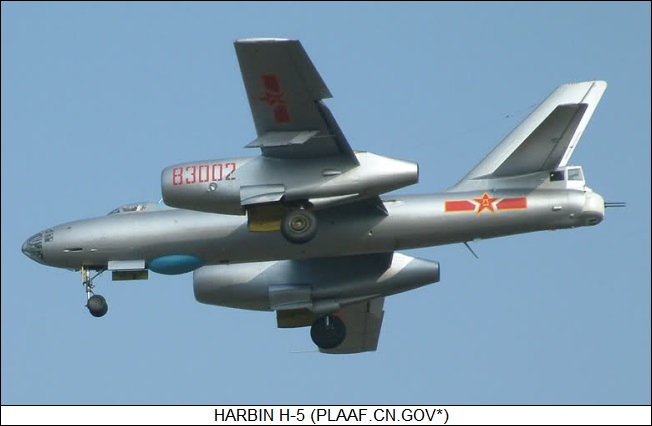
* At the end of World War II, the USSR was lagging the West in jet aircraft design, and Soviet dictator Josef Stalin had made it clear that the nation would catch up by all means possible. Soviet engine designers, most significantly Arkhip Lyulka, had been working on turbojets since before the war, and though German jet engines -- the Junkers Jumo 004 and the BMW 003 -- were used in the very first Soviet jet fighters, the intent was to move on to indigenous Soviet engine designs as soon as possible.
Since air superiority depended on fighter aircraft and since jet fighters were generally superior to piston fighters, the first priority was the development of Soviet jet fighters. However, bombers were not far behind. Beginning in 1945, the OKBs (experimental design bureaus) under the direction of Pavel Sukhoi, Andrei Tupolev, and Sergei Ilyushin began work on the first generation of Soviet jet bomber designs. The Sukhoi OKB never got their design off the ground, while the Tupolev OKB came up with a jet-powered version of their Tu-2 twin-piston bomber, called the "Tu-12" or "Model 77", as a stepping stone to something better.
The Ilyushin OKB came up with the "Il-22", which was along the lines of a scaled-up German Arado Ar-234 jet bomber, with a length of 21.05 meters (69 feet), a wingspan of 23.06 meters (75 feet 8 inches), and an empty weight of 14,950 kilograms (32,960 pounds). It was powered by four Lyulka TR-1 axial-flow turbojets in individual underwing nacelles, with each engine providing a thrust of 12.75 kN (1,300 kgp / 2,865 lbf); featured a dorsal turret and tail turret, with twin cannon each; had a maximum bombload of 2,000 kilograms (4,400 pounds); and a crew of five.
The single prototype performed its initial flight on 24 July 1947, but the Lyulka engines were far from mature: the machine was underpowered and had limited range. It was so obviously a loser that the OKB didn't bother to submit it to state trials.
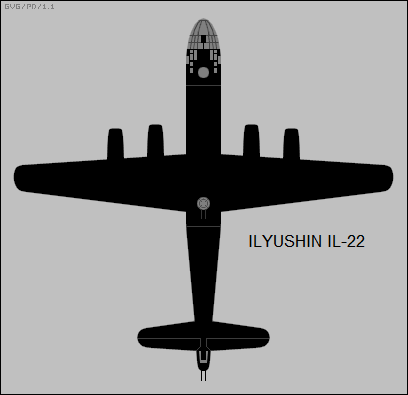
* The biggest problem was that the Soviet Union simply didn't have turbojet engines with adequate power at the time, and in 1946, to tide aircraft development over until the USSR could build satisfactory jet engines on its own, several highly placed aviation officials had approached Josef Stalin to suggest that the Soviet Union buy British turbojet technology. According to the tale, Koba -- "The Boss" -- was sarcastic, replying: "What fool will sell us his secrets?" However, he approved the negotiations, and the British did prove willing to sell the Rolls-Royce Derwent and Nene centrifugal-flow turbojets to the USSR.
This act has been derided as a bad move ever since, even in Russian sources, and there were apparently British officials who protested loudly -- but at the time, the British still had some lingering sympathy for their ally in the war against Hitler, were going through a temporary phase of poor relations with the USA, and the technology involved wasn't classified anyway. In any case, the Nene provided the Soviet Union with a reliable, powerful turbojet, which went into production as the Klimov RD-45F, leading to the improved and uprated VK-1 engine. It would power the Mikoyan MiG-15 fighter, an aircraft that would come as a bit of a shock to the Americans in Korea, and more importantly in the present case, it would power the first really successful Soviet jet bomber.
In late 1947, Sergei Ilyushin proposed development of a tactical jet bomber powered by twin RD-45F turbojets. He believed he could have a prototype in the air by July 1948, leveraging off some of the design of the unsuccessful Il-22 and using the copied engines. Full development began in early 1948, even though the state plan at the time had assigned the Tupolev OKB the task of designing a tactical bomber. However, nobody had told Ilyushin not to build a bomber, and Stalin liked to encourage competition, if often out of an instinct to play people off against each other. Formal approval wasn't granted until June 1948, when the prototype of the "Il-28", as it was designated, was already in taxi testing.
The Il-28 prototype performed its initial flight on 8 July 1948, very much on Ilyushin's schedule, with OKB chief test pilot Vladimir Kokkinaki at the controls, accompanied by radio operator B.A. Yerofeyev and navigator N.D. Sorokin. It was powered by British-built Nene engines, part of a batch that had been obtained as part of the license manufacturing deal. Kokkinaki reported the aircraft handled well and that it was easy to fly, with no major "funnies". A second prototype followed it into the air on 30 December 1948, this machine being powered by production Soviet-built RD-45F engines.
The Tupolev OKB was working in parallel on their tactical bomber design, which would ultimately be known as the "Tu-14", and Andrei Tupolev was not at all happy with the competition, calling the Il-28 a "bastard child". The two aircraft were tested in parallel, leading to a final selection of the Il-28 in May 1949, specifying that the production machine use the uprated Klimov VK-1 engines. Limited production of the Tu-14 was authorized for the Red Navy, though it would only be built in small numbers and would have a forgettable career.
Pre-production examples of the Il-28 were built and evaluated, leading to approval for full production in September 1949. Three state factories -- one each in Moscow, Voronezh, and Omsk -- were assigned to build the bomber, with the first full-production machine rolled out of the Moscow factory in March 1950, to go into VVS (Voyenno Vozdushniye Sily / Red Air Force) service. The Soviet state showed off their new jet bomber at the May Day parade that year, where it could be observed by Westerners. NATO originally assigned the type the reporting name of "Butcher", but this was quickly changed to the much less menacing name of "Beagle".
BACK_TO_TOP* The Il-28 was a simple, robust aircraft, a good example of Soviet design engineering. It was easy to build, maintain, and fly, which was all the more impressive because it had been designed so quickly, obviously by an engineering team with an enormous amount of solid practical experience. It was made mostly of aircraft aluminum alloy and had a long, oval-section fuselage. The fuselage was split lengthwise and built in halves that were fitted together like a plastic model kit. The Il-28 featured a high mounted, two-spar, straight wing with a turbojet attached directly under each wing in a long nacelle. The tail, unlike the wing, was sweptback to improve controllability in dives. Flight controls were conventional, including ailerons, single slotted flaps, elevators, and rudder, with aileron, elevator, and rudder trim tabs. All flight controls were manually actuated, except for the hydraulically-actuated flaps.
The engines were Klimov VK-1 turbojets, with a thrust of 26.5 kN (2,700 kgp / 5,950 lbf) each and electrical starting. The engine nacelles of production machines were wider at the front than they were where they mated the wing, an arrangement that provided better aerodynamics than the straight nacelles of the prototypes -- it seems an early use of the concept of "area ruling" that would become a common feature of supersonic aircraft. A reliable and effective engine bleed scheme was used for wing and tail surface de-icing. A rocket-assisted take-off (RATO) booster could be attached to each side of the fuselage under the wing roots to permit take-offs from short fields or in overload condition.
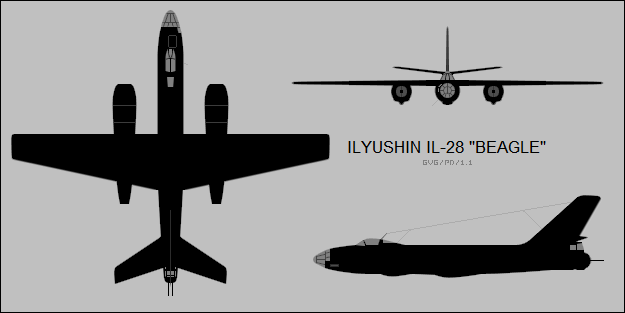
The Il-28 had pneumatically-actuated tricycle landing gear, with the dual wheel nose gear retracting backward, and the single-wheel main gear retracting forward and turning 90 degrees to lie flat in the engine nacelles. Landing gear clearance was good, reducing the likelihood of foreign object ingestion into the engines, and also making rearming the bomber easier. The Il-28 could carry a single KAB-3000 3,000-kilogram (6,600-pound) bomb, but the normal warload was 1,000 kilograms (2,200 pounds) of bombs in the internal bomb bay. The Il-28 had an internal fuel capacity of 7,900 liters (2,085 US gallons) in five tanks around the bomb bay.
Gun armament consisted of twin fixed 23-millimeter cannon in the nose and twin 23-millimeter cannon in a tail turret, with the tail guns aimed by an optical sight. The tail turret featured armor glass and steel armor to protect the tail gunner. Although some sources claim the Il-28's tail turret was copied from the Boeing B-29 Superfortress, that was not the case; it was the first Soviet-designed electro-hydraulic turret. Ammunition supply was 100 rounds per gun for the nose cannon and 225 rounds per gun for the tail cannon. The cannon were originally Nudelmann-Richter NR-23s, but they were replaced later in production by faster-firing Nudelmann-Suranov NS-23s. A camera was fitted to provide post-strike target damage assessment.
___________________________________________________________________
ILYUSHIN IL-28 "BEAGLE":
___________________________________________________________________
wingspan:
21.45 meters (70 feet 4 inches)
wing area:
60.8 sq_meters (654 sq_feet)
length:
17.65 meters (57 feet 11 inches)
height:
6.7 meters (22 feet)
empty weight:
12,890 kilograms (28,420 pounds)
max loaded weight:
21,000 kilograms (46,300 pounds)
maximum speed:
900 KPH (560 MPH / 487 KT)
service ceiling:
12,300 meters (40,350 feet)
range:
2,400 kilometers (1,490 MI / 1,300 NMI)
___________________________________________________________________
The Il-28 had a crew of three, including a pilot and a navigator / bombardier in a forward compartment, and a tail gunner / radio operator in a rear compartment. The two compartments were heated and pressurized using engine bleed air, with the crew also provided with an oxygen system. There was no way to get from one compartment to the other in flight.
The pilot sat under a fighter-type canopy that hinged open to the right, while the navigator / bombardier clambered into the machine through a hatch on the nose forward of the pilot's cockpit and offset to the right. Pictures show it to be something of a climb to get in and out of the machine on ladders, and it's not hard to believe that Il-28 aircrew suffered broken bones every now and then in the process. The pilot and navigator had upward-firing ejection seats, fitted with armor. The tail gunner got into the tail turret through a hatch directly beneath the tail. Since the tailfin blocked use of an ejection seat, he had to bail out on his own through the tail hatch; it opened forward to provide a windbreak and make escape easier.
Avionics systems were fairly sophisticated by the standards of the time, including of course radios and an identification friend or foe (IFF) transponder, but also an autopilot, an automatic direction finder, navigation beacon receivers, and both low-altitude and high-altitude radio altimeters. The navigator / bombardier sighted the bombload using an OPB-5S optical sight when visual bombing was possible, and a PSBN-M bomb-aiming radar when not. The radar antenna was in a radome on the belly underneath the pilot's cockpit; the radar was also used as a navigation aid. The Il-28 was one of the first Soviet bombers to be fitted with radar as a standard feature, and unsurprisingly reliability of the radar system was poor -- in fact, in the early days it hardly ever worked. However, the radar was designed in a modular fashion, with "line replaceable units", and servicing was generally straightforward.
There were a number of improvements to the Il-28 during the course of production, including a new formation light scheme; electrical deicing for the cockpit windscreen; bleed air deicing for the engine inlets; a revised fuel system featuring improvements such as self-sealing tanks; new ejection seats with leg restraints, a face visor, plus automatic seat belt tightening; and a brake parachute.
BACK_TO_TOP* Since the Il-28 was the first jet bomber to reach widespread service with the VVS, there was an obvious need for a trainer variant to familiarize pilots with such a relatively fast machine. Work on an Il-28 trainer, to be designated "Il-28U", with the "U" standing for "uchebniy (trainer)", began in the fall of 1949, with a standard Il-28 bomber taken off the production line to be converted into the prototype. In its new trainer configuration, it performed its first flight on 18 March 1950, with Vladimir Kokkinaki at the controls.
The Il-28U was an Il-28 bomber with a new nose forward of the pilot's cockpit, featuring a second cockpit and no nose glazing. The trainee flew in the original pilot's cockpit, with the flight instructor in the new cockpit. It was an ugly but effective aircraft. Combat systems, including radar and cannon, were removed, with the aircraft ballasted to maintain pitch trim. Trials showed the Il-28U to have very much the same handling and performance as the Il-28 bomber variant, except for a slightly improved climb rate.
The prototype went through its paces for the camera at the 1950 May Day parade, and was given the NATO reporting name of "Mascot". Full-scale production began in July 1950, with the type remaining in first-line East Bloc service as a bomber trainer until the early 1970s.
* Work on a reconnaissance variant, the "Il-28R", where the "R" stood for "razvedchik (reconnaissance)" followed quickly on the heels of the trainer development program, with an Il-28 pulled off the production line for conversion into a prototype in early March 1950. The Il-28R prototype performed its first flight on 19 April 1950, once again with Kokkinaki at the controls.
The Il-28R featured a camera suite carried in the bomb bay, with a special camera mount for oblique photography to the left in the rear fuselage. Day or night cameras could be carried, and up to 12 flares could be carried in the rear bomb bay for night missions. The fuel supply was increased by fitting a larger fuselage tank that crowded into the rear of the bomb bay, and by adding wingtip tanks. The increased fuel weight made for a higher maximum take-off weight, and the landing gear was reinforced accordingly. The landing gear was actuated by a hydraulic system instead of the pneumatic system used by other Il-28 variants, and an interesting scheme was implemented that spun up the mainwheels before landing to reduce tire wear. Pilots apparently found this a nice little feature that made for smooth touchdowns.
Cannon armament was retained, except for the right nose cannon, which was removed to make room for camera controls. The bombing / navigation radar was also sometimes removed as well. An inflatable dinghy could be carried in the bomb bay for long overwater flights. Production was authorized in late 1951, and the Il-28R was soon in VVS service.
* Apparently the Red Navy didn't find the Tu-14 very satisfactory and acquired Il-28s to complement and replace it. The Red Navy Il-28s initially flew in standard bomber configuration, but at least some were modified to carry the RAT-52 torpedo, which was propelled by a solid-rocket motor. Trials were also performed with an Il-28 with underwing racks inboard of the engine nacelles to allow it to carry three rocket torpedoes, but unsurprisingly the external stores badly cut into performance, and this configuration was not adopted for service.
The field-modified Red Navy Il-28s were not suitable for carrying standard torpedoes or mines, and so the Ilyushin OKB developed a dedicated torpedo-bomber variant, the "Il-28T". It featured a longer weapons bay; the wing shifted back about 10 centimeters (4 inches) to compensate for the change in center of gravity; modified nose glazing, with a blister on the bottom, to accommodate a torpedo sighting system; and carriage of an inflatable dinghy. The right nose cannon was deleted and the internal fuel capacity was reduced, with Il-28R-style wingtip tanks adopted to compensate. Operational stores included bombs, rocket or conventional torpedoes, and naval mines. Two prototypes were built as conversions of standard Il-28s, with the first flying on 8 January 1951, with Kokkinaki at the controls. The type entered limited production in the summer of 1951.
Late in the 1950s, the Red Navy converted a batch of Il-28s and Il-28Ts to an anti-submarine patrol configuration, designated the "Il-28PL". Modifications were fairly minor, with the machines fitted with a sonobuoy receiver and qualified for carriage of sonobuoys and depth charges in the bomb bay. Homing torpedoes were qualified later.
* The Soviets detonated their first atomic bomb in 1949. The first weapon was a direct copy of the big American Fat Man plutonium bomb from plans obtained by Red spies in the US atomic bomb effort, but Soviet nuclear weapons designers had plenty of ideas of their own; they soon came up with a nuclear weapon, the RDS-4 Tatiana, that was small enough to be carried by the Il-28. Two Il-28s were modified to carry this weapon, with the first live drop performed on 23 August 1953.
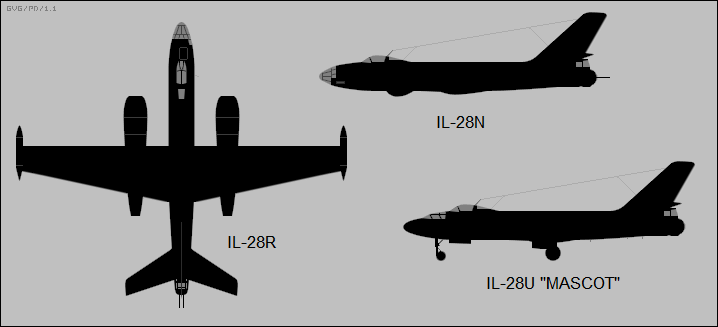
Successful weapons tests led to authorization of production for the RDS-4 and of a purpose-designed Il-28 variant to carry it, of course designated the "Il-28N". The Il-28N featured special provisions for the care and feeding of a nuclear weapon, including a bomb bay heater to keep the munition's control systems from freezing up; blast flash window curtains for the aircrew; and an updated avionics suite, with a new targeting-navigation radar in a much deeper radome providing a distinctive variant recognition feature. Il-28R-style wingtip tanks were also fitted.
* The Soviets were somewhat slow to develop guided weapons, one of the first efforts along this line being a 2,000 kilogram (4,400 pound) radio-controlled glide bomb designated the "UB-2F Chaika (Seagull)". It featured stubby delta wings in a cruciform configuration around the midbody and a twin-fin tail. It was guided by a hand controller by the bombardier on the carrier aircraft, who "eyeballed" the weapon into the target. It was conceptually along the lines of the German Fritz-X glide bomb of World War II and presumably, like the Fritz-X, had a flare fitted to the tail to allow the bombardier to track it visually.
About 30 "Il-28-131" machines were built in 1956 to carry the Chaika under the centerline. They otherwise looked much like a conventional Il-28, except for a small antenna fairing for the radio-control system under the nose. The Chaika was really not much of an advance over the Fritz-X and had a short service life, since the USSR was moving ahead rapidly on guided weapons by that time, but it did give the VVS some experience with the concept.
BACK_TO_TOP* There were a number of minor variants and special modifications of the Il-28, most of which remain obscure. An electronic intelligence (ELINT) variant, the "Il-28RTR", where "RTR" stood for "radio-tecknichsekoy razvedchik (radio system reconnaissance)", was built in some numbers. The distinguishing characteristic of this variant was a second, larger antenna fairing installed under the faired-over bomb bay. The Il-28RTR lacked the wingtip tanks of the Il-28R photo-reconnaissance variant; it is unclear if it had the larger internal tank or reinforced hydraulic landing gear system of the Il-28R.
An electronics countermeasures (jamming) variant, the "Il-28REB", where "REB" stood for "radioelectronnaya borbah (radioelectronic countermeasures)", was also built in some numbers, and is even more obscure. It featured pods on the wingtips that looked like Il-28R wingtip tanks, but were actually jammer gear.
* Two Il-28s, apparently standard bombers, were configured with fallout sampling pods and a shielded, overpressurized cockpit with radiometer warning systems, to monitor nuclear tests. One suspects they were washed off thoroughly on landing before anyone got near them, and were probably written off and buried after their tour of service. A number of demilitarized Il-28s were fitted with atmospheric sampling gear for civilian weather reconnaissance and redesignated "Il-28ZA"; details remain very unclear.
State approval was granted in 1953 for a special Il-28U Mascot variant to train aircrews in use of ejection seats, but it remains unclear if any such machines were actually built. However, in the early 1960s, one Il-28 was given a drastic makeover to perform trials of the ejection seat for the Soviet Vostok space capsule, with ejections from a prominent hump fitted to the spine of the aircraft over the bomb bay, and from a tub tacked on to the tail. Movie cameras were fitted in little fairings on top of and below the wingtips to observe the ejections.
This machine was called the "Il-28LL", where "LL" stood for "letayuschchaya laboritoriya (flying laboratory)". The "LL" suffix was actually something of a general designation suffix for a trials aircraft and there were Beagles flown in other trials that were also referred to as the "Il-28LL", though the Soviets more often didn't bother to give such machines any special designation. In any case, Il-28s were used in:
* In the late 1960s, there was some thought of converting old Beagles to a close-support configuration, what the Soviets called a "shturmovik (stormbird)". There was some thought of mounting a battery of unguided rockets with hollow-charge / anti-armor warheads in the bomb bay, with the rockets firing nearly straight down, but the idea was scrubbed when it was realized that blasting off the rockets would render the aircraft uncontrollable for a short time -- big trouble when flying at low level.
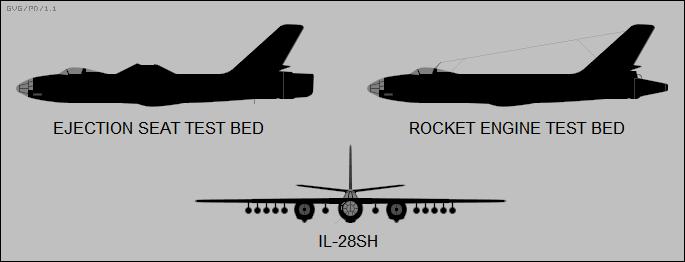
A more conventional configuration was adopted instead, with an Il-28 fitted with twelve underwing stores pylons as a demonstrator and designated the "Il-28Sh", where the "Sh" of course stood for "Shturmovik". There were six pylons on each wing, five of them outboard of the engine and one inboard. The pylons could carry bombs, submunition dispensers, cannon pods, and particularly unguided rocket pods. For example, twelve 57-millimeter unguided rocket pods with 16 rounds each could be carried, giving an impressive warload of 192 rockets. Trials began in late 1967, demonstrating the aircraft's ability to carry a heavy warload and deliver it accurately at low altitude.
There were plans to convert up to 300 Il-28s to Il-28Sh standard, but then second thoughts set in. The Il-28 didn't have the armor needed to allow it to survive ground fire, and it also lacked low-level ejection seats. Apparently a few machines were converted, but saw no real service.
* However, hand-me-down Il-28s were successfully used in a number of other roles. In 1954, a few Il-28 bombers were demilitarized and handed on to the state airline, Aeroflot, for use as mailplanes and for training. They were redesignated "Il-28P", where "P" stood for "pochtovii (mail)". Up to that time, Aeroflot had operated piston airliners, and with jet airliners clearly being the future there was a need to get aircrews up to speed on flying jets. The Il-28, with its benign handling characteristics, was regarded as ideal for the task. The Il-28Ps did their job well, serving for a few years before Aeroflot acquired a fleet of jetliners, beginning with the Tupolev Tu-104 "Camel", derived from the Tupolev Tu-16 "Badger" bomber.
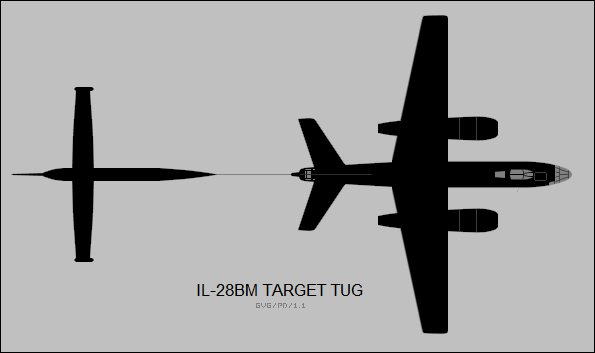
After their retirement to secondary roles, a number of Il-28s and Il-28Rs were converted to target tugs by removing armament and installing a target tow winch in the bomb bay, with the conversions designated "Il-28BM". A winch cable feed system was attached under the tail turret, providing an external recognition feature, and the aircraft were usually patterned with dayglow orange paint -- according to the old joke, as a reminder to fighter pilots that the target was being pulled, not pushed. Later on, the Il-28Ms were configured to carry and launch target drones, with a drone carried on a pylon inboard of the engine under each wing.
Old Il-28s were used as target drones themselves under the designation of "Il-28M". In some cases, the drones were hardly worthy of the name; a pilot took the aircraft up, set the autopilot, and then ejected to allow the bomber to cruise on mindlessly until it was shot down or ran out of fuel. During the mid-1950s, one pilot, Fyodor Bogdanov, made 31 ejections as part of this effort. However, fully radio-controlled drones were produced by conversions as well.
BACK_TO_TOP* The exact number of Il-28s actually built is unclear, estimated to be about 3,000, with roughly half of those going into Soviet service. The type was in full service with the VVS by the end of 1950, and went into service with the AVMF, the Red Navy air arm, in 1951. By the mid-1950s, the Il-28 was an important element of Soviet tactical air power, providing a powerful conventional and nuclear strike capability. Aircrew liked the Il-28 because of its good performance, easy handling, relatively comfortable crew accommodations, reliability, and sturdiness. The VK-1 engines were rugged, able to swallow birds and branches without much of a hiccup. One Il-28 ditched in the Baltic, remained afloat, was towed to shore, and restored to flight service.
Although improvements in fighter performance rendered the Beagle more vulnerable as time went on, VVS pilots became skilled at low-level operations, where the bomber would be hard to catch. If the big shooting match had taken place between the East and West in Europe in the 1950s, Il-28Ns would have made tactical nuclear strikes on major targets, protected by Il-28REB jammer platforms and conventionally-armed Il-28s performing "defense suppression" strikes on air defense sites. Forward airfields were built in Poland and East Germany to permit strikes deep into Western Europe.
Il-28s did see service in the 1956 Soviet occupation of Hungary, performing reconnaissance missions, with one shot down. By the late 1950s, the Il-28 had been mostly relegated to second-line duties in Soviet service, particularly the target tug and target roles. Many Il-28s were scrapped in the early 1960s, even machines with minimal flight hours, though some Il-28Rs remained in service for a time, long enough to support the Soviet occupation of Czechoslovakia in 1968. As mentioned, the drive to convert survivors to the Il-28Sh attack configuration didn't pan out, but the Il-28 still lingered in Soviet service into the 1980s.
* The other rough half of Il-28 production went into foreign service all over the world. The People's Republic of China was the biggest user by far, with deliveries beginning in 1952 leading to a fleet of several hundred Il-28s and Il-28U trainers. Chinese Il-28s put in a showing late in the Korean War as an implied threat against the Americans and their allies, but it doesn't appear they saw any combat action. Chinese Il-28s did see some combat in 1956, performing airstrikes on the Tachen Islands north of Taiwan, which were claimed by the Nationalist Chinese. The Il-28s suffered badly at the hands of Nationalist Thunderjets and Sabrejets.
Chinese Il-28s also saw some action during the Chinese invasion of Tibet in 1959, and were apparently used for reconnaissance overflights of Taiwanese territory, with a few said to have been shot down. One Chinese Il-28 crew defected to Taiwan in 1966, setting down on an airstrip that seems to have been too short for it, to suffer some damage and injury to all three crew, the tail gunner dying the next day. The aircraft was not all that badly damaged and was quickly repaired, to be given a good looking over and, according to the story, used for covert flights over the mainland.
In the early 1960s the USSR and Red China had a falling-out, and so a program was begun at the factory at Harbin in China to build spares for existing Chinese Il-28s, as well as new-build aircraft. The first prototype of a Chinese Il-28, designated the "H-5", took to the air in September 1964, with full production beginning in 1965. By that time the type was thoroughly obsolete, but Chinese design and manufacturing capabilities weren't up to the job of building more sophisticated aircraft; as noted, the Il-28 had been specifically designed to be simple and easy to build. The Beagle was better than nothing, and could give Chinese industry experience useful for building more advanced machines. Production of the Il-28U trainer as the "HJ-5" began in 1970, followed by a reconnaissance variant, the "HZ-5", later in the decade. A navalized / torpedo-bomber variant was also apparently built.
Chinese Beagles were not perfect copies of Soviet machines, incorporating an extensive number of changes to fit Chinese manufacturing and operational practice; it would take a very well trained eye to tell Soviet and Chinese machines apart, however. The Beagle served with the Chinese military well into the 1990s, and a few aircraft may still be flying in various second-string roles. The Chinese also exported their production, with the H-5, HJ-5, and HZ-5 redesignated "B-5", "BJ-5", and "BZ-5" respectively.
* Of course, the next biggest group of Beagle operators were the Communist nations of Eastern Europe, including Albania (which flew Chinese-built Beagles); Bulgaria; Czechoslovakia; East Germany; Hungary; Poland; and Romania (which obtained both Soviet-built and Chinese-built Beagles). Czechoslovakia was a particularly enthusiastic user, building the Il-28 and Il-28U under license as the Avia "B-228" and "CB-228" respectively. Although East Germany used the Il-28 mostly as a target tug, a few were used for various trials, for example as engine test beds, one with a Walter M-701 turbojet installed in the tail, another with a Pirna 014 turbojet carried on the centerline.
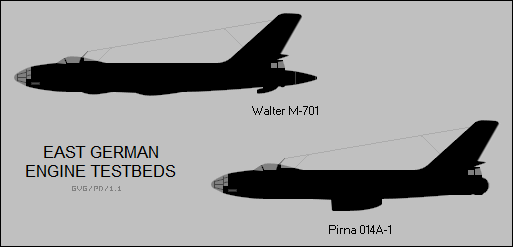
Some Hungarian Il-28s may have performed counterstrikes on invading Soviet troops in the 1956 invasion, though resistance was quickly crushed. Although in general the Beagle faded out of service in Eastern Europe in the 1980s, the Romanians were still operating some as target tugs early in the 21st century. The Romanians, incidentally, nicknamed the Il-28 "Blandul Ben (Gentle Ben)", after a famously corny 1960s American TV series about a loveable pet black bear, as a tribute to the aircraft's easy flying characteristics -- along with a hint that it still needed to be treated with respect.
Finland also obtained five Il-28Rs and one Il-28 in the 1960s, with three of these converted to target tugs. Ironically, the Finns used their Il-28Rs to spy on the neighboring "Bear" to the east, skirting the border and then drifting over when the coast seemed clear to inspect any suspicious activity on the eastern side of the fence. The local Soviet air defense command found the Finnish Beagles a persistent nuisance, but never managed to shoot one down.
* Middle Eastern and African operators of the Il-28 included Algeria; Egypt; Iraq; Morocco; Nigeria; Somalia; Syria; and Yemen. Egypt was the biggest user of this group, operating up to about 70, mostly Czech-built aircraft. The Egyptian Air Force (EAF) received its first batch just in time for the 1956 Mideast War, which occurred when Egyptian President Nasser nationalized the Suez Canal, provoking the British, French, and Israelis into attacking Egypt to take it back. Since the EAF didn't have aircrews trained for their Beagles at the time, the bombers were sent to friendly countries to sit out the war, which was fortunate since the EAF was chewed up fairly badly in the conflict. The war ended when the US told Britain to get out, with the operation then collapsing in recriminations.
EAF Il-28s fared much worse in the June 1967 "Six Day War", which was initiated by a meticulously planned Israeli air blitz that smashed Arab air power on the ground. The Il-28 was a high-priority target for Israeli pilots since it posed a threat to Israeli cities; those Egyptian Beagles that did survive the initial tsunami and took to the air were quickly shot down. Syria, which had obtained a number of Il-28s from Egypt, took a similar beating. The Israelis destroyed several dozen Il-28s in all.
The conflict didn't really end after six days, it just went down to a simmering "war of attrition" while the two sides prepared for the next round. Two Il-28Rs were shot down in reconnaissance missions over Israel in 1970, with an Il-28BM target tug also shot down by an "Egyptian" surface-to-air missile (SAM) in that year. The term "Egyptian" is in quotes because the Soviets were helping the Egyptians build up a dense and formidable air-defense system, and the SAM was launched by a Soviet crew; they were exonerated because the Il-28BM's IFF system was broken, and the SAM crew was on alert for Israeli aircraft then operating in the vicinity.
The EAF's Il-28s lingered into service for the 1973 Ramadan / Yom Kippur War, in which the Egyptians were far better prepared and were accordingly much more successful, and may have performed reconnaissance sorties in the conflict, but they were phased out over the next decade.
Nigeria operated a handful of Il-28s handed down from Algeria and Egypt during the Nigerian civil war in the late 1960s, when the province of Biafra tried to secede from the country. The Nigerians really didn't have the training and logistics to fly or maintain the aircraft, and their Il-28s were all apparently either lost in accidents, or grounded due to lack of spares and maintenance.
Iraq's Il-28s sat out the Six-Day War, but they did apparently take part in operations against Kurdish insurgents in the 1970s. It doesn't appear that they were still in service during the Iran-Iraq War in the 1980s.
The last known combat service of the Il-28 was in Afghanistan, with the Communist Afghan government using the type against Mujahedin insurgents in the close-support role with some success. The tail turret proved very handy, since the tail gunner could "hose down" the Mujahedin with large-caliber ammunition to make them keep their heads down after an attack pass; apparently the Il-28Sh close-support variant was a better idea than the Soviets had thought. Not one Afghan Il-28 was lost in combat, but the Soviet-backed Afghan government was not very popular, and all the Afghan Il-28s were destroyed on the ground in 1985 by explosive charges in an action that was clearly an "inside job", performed with the assistance of disaffected Afghan military personnel.
* Asian operators, aside from China and Afghanistan, included Indonesia; Kampuchea (Cambodia); North Korea; and North Vietnam. North Vietnam's Il-28s were Russian-built hand-me-downs from China. They never saw any action against US forces during the Vietnam War, but they did make the Americans nervous enough to decide to set up an interceptor force in the theatre to counter them.
North Vietnam did fly them to support Pathet Lao insurgents in Laos in the early 1970s, with Soviet pilots performing at least some of the sorties. It is unclear if North Vietnamese Il-28s flew in the invasion of Kampuchea in 1979 that ousted the infamously savage Pol Pot regime, but Pol Pot's forces had used the Il-28 against insurgents before that time.
* The only Il-28 operator (of sorts) in the New World was Cuba. In the early 1960s, the US stationed Jupiter intermediate range ballistic missiles (IRBMs) in Turkey. Along with the "ring of steel" of US bomber bases surrounding the USSR, the Jupiters made the Kremlin nervous since they could hit Moscow and other targets in the western USSR with so little warning. Conveniently, however, Cuba had recently gone through a revolution that installed a Communist government under Fidel Castro on the island, and Soviet Premier Nikita Khrushchev decided that he could use the opportunity of having a Red ally in the Caribbean to help balance the nuclear score with the US.
Soviet IRBMs and 42 Il-28Ns were shipped to Cuba in September 1962; of course, the Il-28Ns were to be flown by Soviet crews, and it is unclear if they were even given Cuban markings. Khrushchev reasoned that the Americans, having put missiles and bombers on his doorstep, would not be in a good position to object if he did the same in return -- but when the US got wind of the operation, their reaction was loud and belligerent. Although the generals pressed for direct military action against the missiles and bombers, US President John F. Kennedy chose to declare a blockade of Cuba instead -- cosmetically labeled a "quarantine", since under international law, blockades were acts of war.
The USSR did not try to challenge the blockade, and when the Soviet field commander in Cuba, disobeying orders from the Kremlin, shot down an American U-2 spy plane, killing the pilot, Khrushchev realized that matters were spiraling rapidly out of control. He hastily announced that the missiles and bombers would be withdrawn; the Il-28Ns were crated up and shipped back to the USSR. They were placed on the upper decks of the transports to show the US that they were in fact being withdrawn, and since they were not protected against corrosion, a number of them had to be scrapped once they got back home.
The Americans quietly withdrew the Jupiters from Turkey not long afterward, partly because they had been rendered obsolete by new intercontinental missiles, and partly because the "Missile Crisis", as it would be known to history, had sensitized the US to the destabilizing nature of missiles so close to the Soviet heartland.
BACK_TO_TOP* The Ilyushin OKB made several attempts to build substantially-improved versions of the Il-28, and also developed a number of potential successors, though they all proved to be dead ends.
The first attempts were based on fitting the Il-28 with the Klimov VK-5 engine, an uprated version of the VK-1 / Nene that had much the same configuration, but provided about 15% more thrust. A prototype of an improved reconnaissance variant with VK-5 engines, designated the "Il-28RM", was flown in 1952 and 1953. Two prototypes of a bomber variant with the VK-5, conversions of standard Il-28s not assigned any new designation, were flown in 1953; as was a single prototype of a VK-5-powered torpedo bomber, designated "Il-28TM". Performance was significantly improved, but the VK-5 engine never went into production, since by that time Soviet engine designers had caught up with the West, building engines generally superior to any warmed-over derivative of the Nene and with much more growth potential.
* The Ilyushin OKB considered several bomber designs as follow-ons to the Il-28, with such efforts following two paths. One path was to simply build a bigger Il-28, which emerged as the "Il-46". It looked so much like the Il-28 that a naive observer might confuse the two, except if they were placed side-by-side: the Il-46 was about twice as heavy as the Il-28, with a span of 29 meters (95 feet 2 inches) and a length of 25.32 meters (83 feet 1 inch). One Russian writer commented that, following the Il-28's NATO reporting name of "Beagle", the logical assignment for the Il-46 would have been "Borzoi", the big and gruesome-looking dog somewhat better known in the US as the "Russian wolfhound".
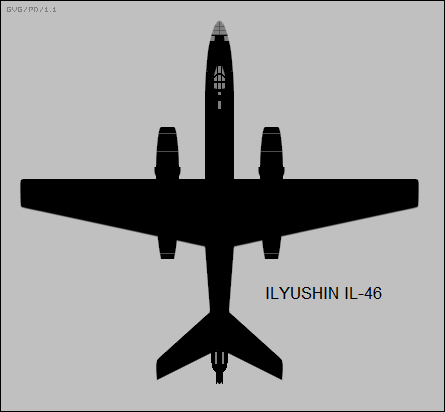
There were obvious detail differences as well, such as slimline nacelles with Lyulka AL-5 axial-flow turbojets providing 49.0 kN (5,000 kgp / 11,025 lbf) thrust each, plus a different canopy arrangement. Aircraft systems were of course improved overall, though the cannon armament scheme of the Il-28 was retained; it seems a bit odd to see such a big aircraft fitted with twin fixed forward-firing cannon.
Initial flight of the single prototype was on 3 March 1952, of course with Kokkinaki at the controls. It passed its state trials, but was never adopted for service, and a second swept-wing prototype, designated "Il-46S", was not completed.
* The other path, for which records remain extremely obscure, involved swept-wing bombers, beginning with a swept-wing version of the Il-28 known as the "Il-28S". Analysis showed that this design offered little performance improvement and it never got off the drawing board, but a somewhat more radical redesign, the "Il-30", was actually built.
The Il-30 looked very much like an Il-28, except for swept wings, slimmer nacelles with axial-flow engines, and "bicycle" landing gear, with twin-wheel main gear assemblies fore and aft on the fuselage and small outrigger landing gear under the engine nacelles. Not much is known about the Il-30 in the West, with most of the data consisting of a single photograph of the machine sitting on the ground. Such other data as is available is sketchy, inconsistent, and obviously too unreliable to bother citing here. It's not even clear that the Il-30 was ever flown.
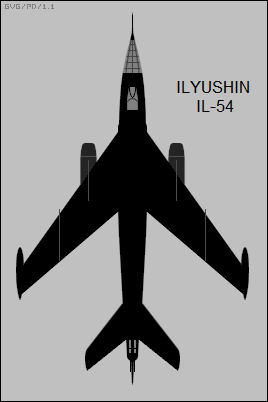
However, the Il-30 did lead to a bigger and more advanced machine, the "Il-54", with roughly the same general description as the Il-30 -- swept wings, axial-flow engines, and bicycle landing gear, in this case with the outriggers stowed in pods on the wingtips -- but much sleeker, with greater wing sweepback, engines in nacelles mounted on underwing pylons instead of mated directly to the wings, and a prominent wing fence outboard on each wing. It was powered by twin Lyulka AL-7 turbojets with 63.8 kN (6,500 kgp / 14,330 lbf) thrust each, had a wingspan of 17.8 meters (58 feet 5 inches), a length of 21.8 meters (71 feet 6 inches), and a weight apparently about 50% greater than the Il-28.
The Il-54 is believed to have performed its first flight in 1955, with (who else?) Kokkinaki at the controls. It was clearly capable of high subsonic performance, with the Soviets claiming it could break Mach 1 in level flight at altitude. Interestingly, the fuselage was not area-ruled. In any case, although the Il-54 looked intriguing -- something like a Yakovlev Yak-28 "Firebar" interceptor, scaled up by a big factor -- it was not adopted for service.
* In the end, Andrei Tupolev would have a bit of revenge on Sergei Ilyushin, since the Tupolev OKB would be the source of all the nation's major bombers for the rest of the country's existence, the Ilyushin OKB specializing in jetliners and cargolifters instead. Tupolev's jab at the Il-28 as a "bastard child" would end up having some foundation in fact.
Although the Il-28 was an excellent aircraft for its time, sometimes being compared to the extremely successful British English Electric Canberra, Tupolev's bombers would overshadow the Il-28 and most Beagles would end up being scrapped even when the type was still useful. The Il-28 was a successful design, but it never quite had the luck to become a truly classic aircraft.
BACK_TO_TOP* The following list gives a variant summary for the Il-28:
_____________________________________________________________________ Il-28 standard "Beagle" bomber variant Il-28U twin-cockpit unarmed "Mascot" trainer Il-28R reconnaissance variant Il-28T Red Navy torpedo bomber variant Il-28N nuclear bomber with larger radome Il-28-131 carrier aircraft for Chaika glide bomb Il-28RTR ELINT variant Il-28REB countermeasures variant Il-28PL Red Navy anti-submarine patrol conversion with sonobuoys Il-28ZA civilianized weather reconnaissance conversions Il-28LL designation of several "flying laboratory" conversions Il-28Sh experimental "shturmovik" close-support conversions Il-28P civilianized Il-28s used by Aeroflot as mailplanes Il-28BM target tug conversions Il-28M target conversions H-5 (B-5) Chinese-built Il-28 HJ-5 (BJ-5) Chinese-built Il-28U HZ-5 (BZ-5) Chinese-built Il-28R equivalent B-228 Czech-built Il-28 CB-228 Czech-built Il-28U _____________________________________________________________________
* Sources include:
* Revision history:
v1.0.0 / 01 aug 05 v1.0.1 / 01 jul 07 / Review & polish. v1.0.2 / 01 jun 09 / Review & polish. v1.0.3 / 01 may 11 / Review & polish. v1.0.4 / 01 mar 13 / Review & polish. v1.0.5 / 01 feb 15 / Review & polish. v1.0.6 / 01 jan 17 / Review & polish. v1.0.7 / 01 dec 18 / Review & polish. v1.0.8 / 01 oct 20 / Review & polish. v1.0.9 / 01 aug 22 / Review & polish.BACK_TO_TOP
